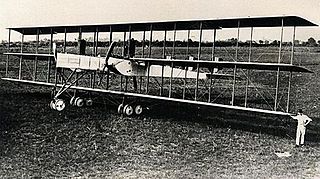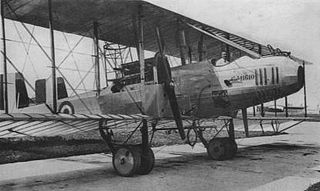Related Research Articles

Caproni, also known as Società de Agostini e Caproni and Società Caproni e Comitti, was an Italian aircraft manufacturer. Its main base of operations was at Taliedo, near Linate Airport, on the outskirts of Milan.

The Caproni Ca.3 is an Italian heavy bomber of World War I and the postwar era. It was the most produced version of the series of aircraft that began with the 1914 Caproni Ca.1 and continued until the more powerful 1917 Caproni Ca.5 variant.

The Caproni Ca.4 was an Italian heavy bomber of the World War I era.

The Caproni Ca.1 was an Italian heavy bomber of the World War I era.

The Caproni Ca.2 was an Italian heavy bomber of the World War I era.

The Caproni Ca.5 was an Italian heavy bomber of World War I and the postwar era. It was the final version of the series of aircraft that began with the Caproni Ca.1 in 1914.

The Caproni Ca.60 Transaereo, often referred to as the Noviplano (nine-wing) or Capronissimo, was the prototype of a large nine-wing flying boat intended to become a 100-passenger transatlantic airliner. It featured eight engines and three sets of triple wings.

The Caproni Ca.165 was an Italian biplane fighter developed just before World War II, but produced only as a prototype, as the competing Fiat CR.42 Falco was selected for series production.

The Caproni Ca.101 was a three-engine Italian airliner which later saw military use as a transport and bomber. It was designed in 1927 and first flown in 1928.

The Caproni Ca.132 was a prototype for a large aircraft built in Italy in 1934, intended for use as either a bomber or airliner. It was a conventional low-wing cantilever monoplane, powered by a radial engine on each wing and in the nose. The main undercarriage was housed within large streamlined spats. Configured as an airliner, it would have seated 20 passengers.
The Grahame-White Ganymede was a prototype British heavy night bomber intended to serve with the Royal Air Force in the First World War. A large, three-engined, twin-boom biplane, the sole prototype Ganymede did not fly until after the war had ended, and although an attempt was made to convert the aircraft to an airliner, it was unsuccessful.
The Caproni-Campini Ca.183bis was an Italian projected high-altitude fighter intended to have both piston and jet propulsion.

Giovanni Battista Caproni, 1st Count of Taliedo, known as "Gianni" Caproni, was an Italian aeronautical engineer, civil engineer, electrical engineer, and aircraft designer who founded the Caproni aircraft-manufacturing company.

The Caproni Ca.193 was an Italian liaison and air-taxi aircraft that was offered to the Italian Air Force as an instrument flight trainer and to the Navy for liaison. Design work started in 1945 and only the prototype was built. It was the last aircraft the Caproni company designed and built in Milan.
The Caproni Ca.131 was a prototype for a large aircraft built in Italy in 1934, intended for use as either a bomber or airliner. It was a conventional low-wing cantilever monoplane, powered by a radial engine on each wing and in the nose. The main undercarriage was housed within large streamlined spats. Configured as an airliner, it would have seated 17 passengers.

The Caproni Ca.7 was a proposed biplane designed by Caproni in the early 1910s.
The Caproni Ca.66 and Caproni Ca.67 were Italian night bomber aircraft designed to re-equip the post-World War I Regia Aeronautica.

The Caproni Ca.105 was a multirole high wing single engine monoplane developed by the Italian aeronautical company Aeronautica Caproni in the late 1920s.

The Caproni Ca.53 was an Italian prototype light bomber built in the last months of World War I.
References
- 1 2 3 Mulder, Rob. "The civilian transport aircraft of Caproni (1918–1939)" (PDF). Norway: www.europeanairlines.no. Retrieved 9 April 2012.